The Via Dolorosa
Note added in December 2023: This article, which I wrote in 2014, could just as aptly apply today, when the Palestinians in Gaza and the Israelis are in conflict yet again.
A 24-hour ceasefire has been agreed, and swiftly failed. Palestinian civilians are suffering terribly – many dead and wounded, houses destroyed, shortage of food – and Israelis, particularly in Ashkelon, are living in fear of the next rocket attack. Only the politicians on each side seem to want this war to continue.
Nevertheless, I insist on believing that a way will be found out of this impasse, and Jerusalem can again become the much-touristed city that it often is.
The Via Dolorosa
This post is about one of the most popular destinations in Jerusalem: the Via Dolorosa. The Via Dolorosa is also known as the Stations of the Cross: the steps taken by Jesus from conviction to resurrection. The exact route is disputed, but yesterday we walked the currently accepted stops.
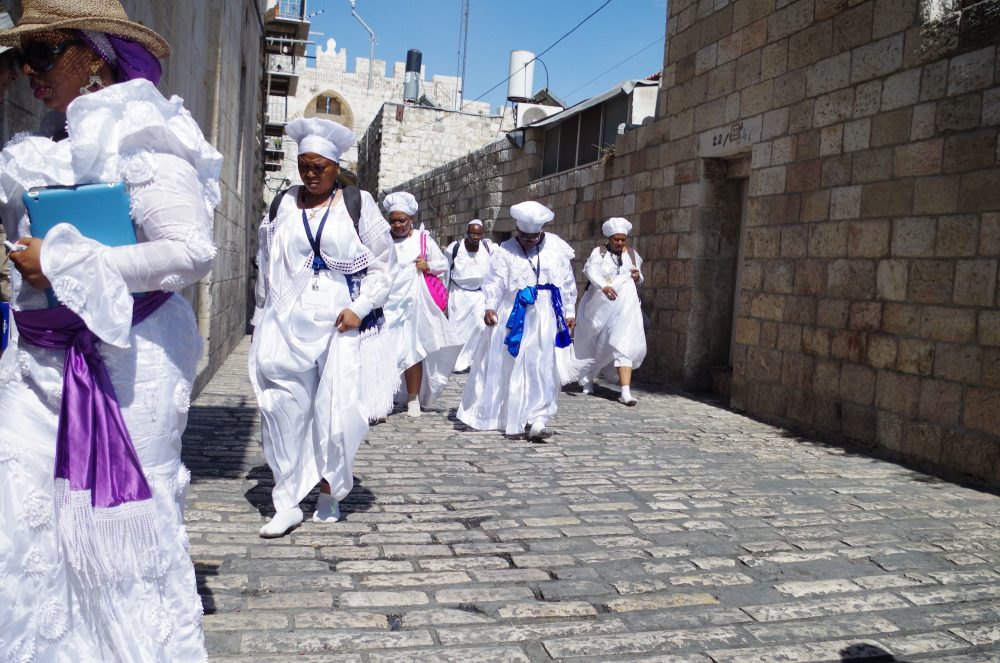
Keep in mind that we are not Christians, nor are we religious. Many, perhaps most, people who walk this route are pilgrims: they have come to Israel because of their faith, and wish to see and touch and be touched by the places where Jesus walked. If you come here, you are likely to see such pilgrims, sometimes carrying crosses to feel even more deeply how Jesus felt as he carried the cross to the place of crucifixion.
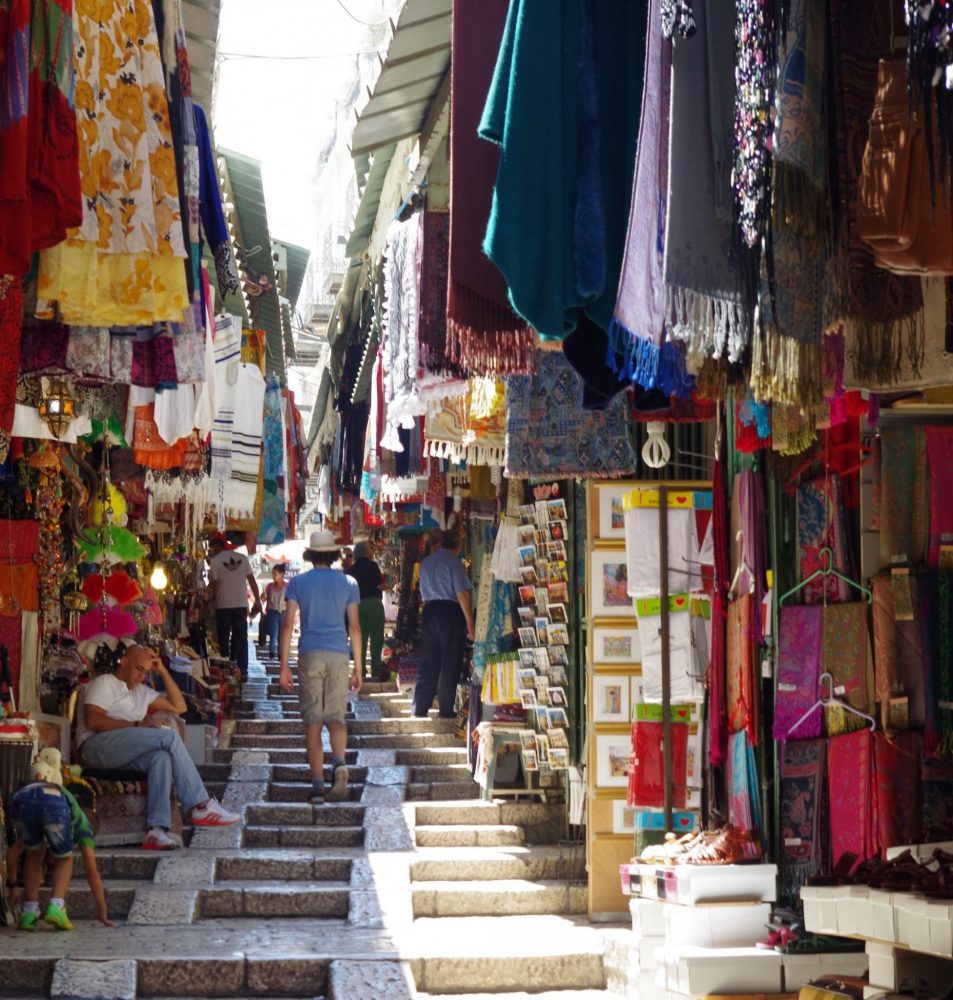
As we explored the Via Dolorosa, we followed a large group of Nigerian pilgrims, all dressed in white, who sang hymns at each stop as they went.Many of the stops are nothing more than a mark on the wall, such as the one designating the spot where Veronica wiped sweat from Jesus’s forehead, or a small chapel, like the one where Jesus is said to have fallen for the second time.
What’s fascinating is that the route winds through the Muslim quarter of the city, and it’s lined with small shops selling souvenirs of all sorts. And when I say “all sorts,” I mean I was struck by the equal-opportunity approach to selling souvenirs. There were Christian items such as crosses and rosaries, Muslim items such as prayer beads, and Jewish items such as stars of David and menorahs. The storekeepers were all Muslim, I think.
I also noticed that the shopkeepers were much less pushy towards the passing tourists than during my past visits, even though there were far fewer tourists than normal on a typical Saturday. In the past I got annoyed by how the shopkeepers never seemed to be able to take “No, thank you!” for an answer, and would keep insisting that I come look at their shop. This time, a simple “No, thank you!” had the desired effect. Western tourists don’t like to be pushed, and perhaps that message has gotten through. Or perhaps business is so bad that a certain level of despair has set in.
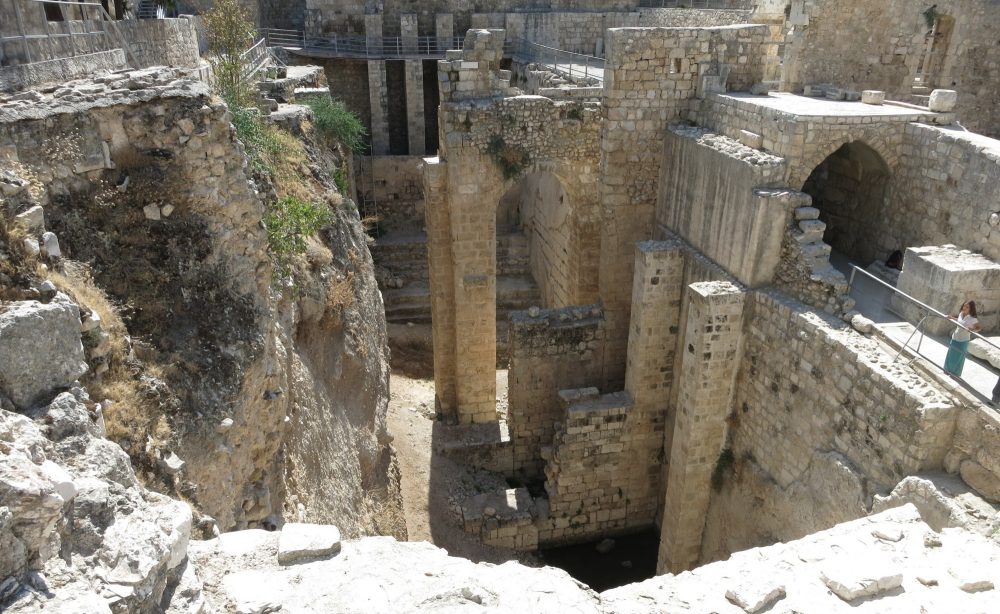
There are several interesting stops on the Via Dolorosa. The crusader-era Church of St. Anne is the site of the pools of Bethesda, and a lovely island of calm in a noisy, crowded part of the city.
If you’re lucky and the Al-Omariyeh school is open, you can go upstairs to a window overlooking the Dome of the Rock for a great picture-taking opportunity. The entire Temple Mount is closed to tourists right now, so this will be the only glimpse we’ll get this visit.
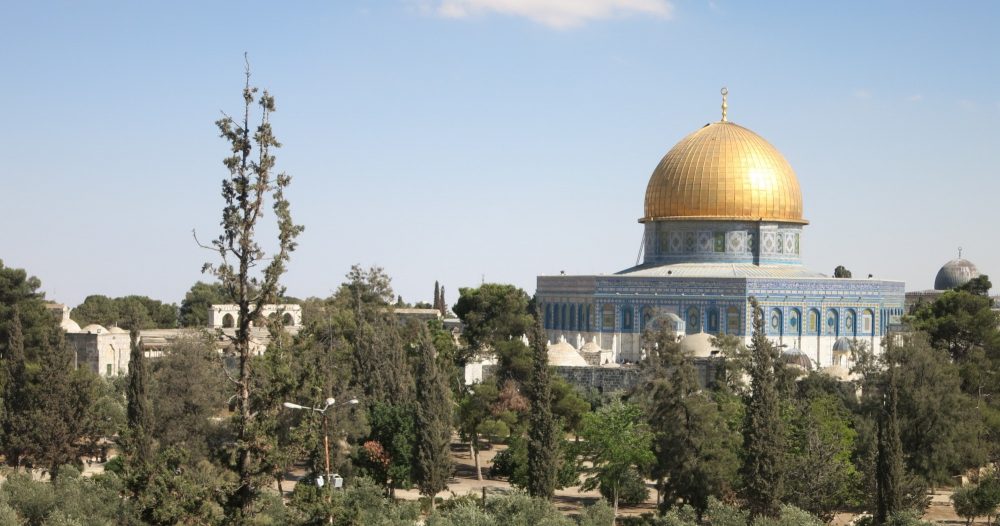
The Church of the Holy Sepulchre
The highlight, though, of the Via Dolorosa, is the Church of the Holy Sepulchre. I’ve visited here on every trip to Israel because it’s such a fascinating place.
The architecture
There isn’t any. Or rather, it’s a mishmash of everything. The exterior is awkwardly framed by the neighboring buildings, with none of the grace of the great European cathedrals like Notre Dame. The central hall, if you can call it that, is lined with Roman columns, presumably from an early shrine. The floors are paved with stones from different periods, worn to different degrees depending on their age, with steps up or steps down for no apparent reason. Much of the building is medieval or Byzantine, and it’s been added to, modified, damaged and rebuilt so many times over the centuries that there seems no rhyme or reason to its layout.

Sectarianism
The Jews and the Muslims aren’t the only ones who have trouble getting along in Jerusalem. A range of ancient Christian sects shares this church, and that, apparently, leads to conflict from time to time. The sects follow a strict schedule of worship so that they all get a turn. Stay in the church for a while, and you’re likely to see a “service” taking place, with, for example, Greek Orthodox priests chanting prayers. Every so often a series of bells chime and clang loudly, presumably to sound the changes of turns.
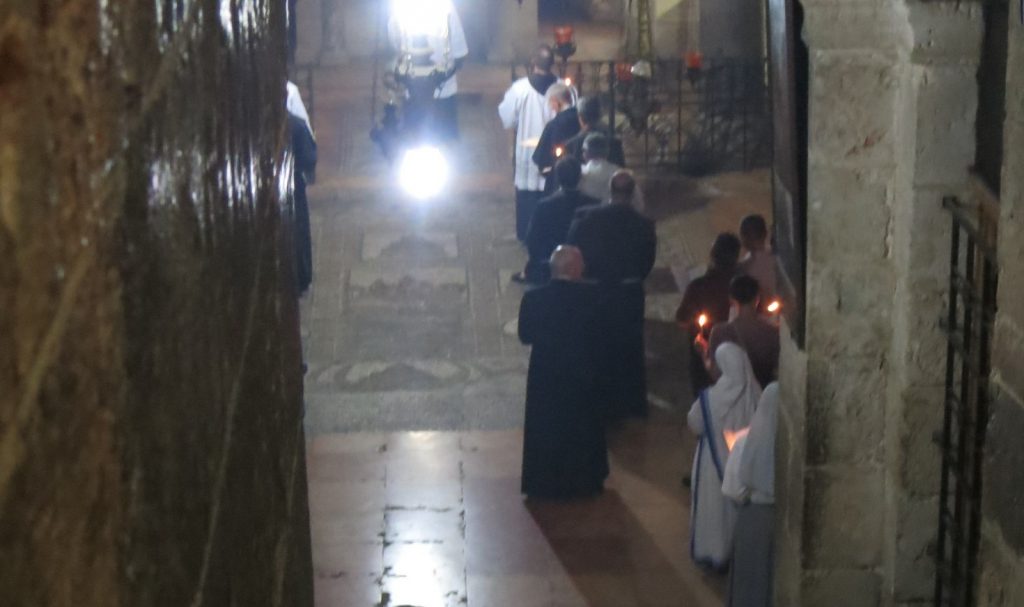
Each different sect has claimed territory as well. Up a steep stairway is a Franciscan chapel, the 10th and 11th stations of the cross, where Jesus’s clothes were removed before the crucifixion and where he was nailed to the cross. Next door is the Greek Orthodox chapel, the 12th station, where Jesus is said to have been crucified. The tomb itself, which all the sects share, is the 14th station, but the Coptic Church has added a small chapel to the back of it. Up a back stairway are two more chapels: one is Ethiopian, I think, and I’m not sure about the other.
Faith
For many Christians, visiting the Holy Sepulchre is a matter of faith, and that’s certainly visible if you stay a while and observe the other visitors.
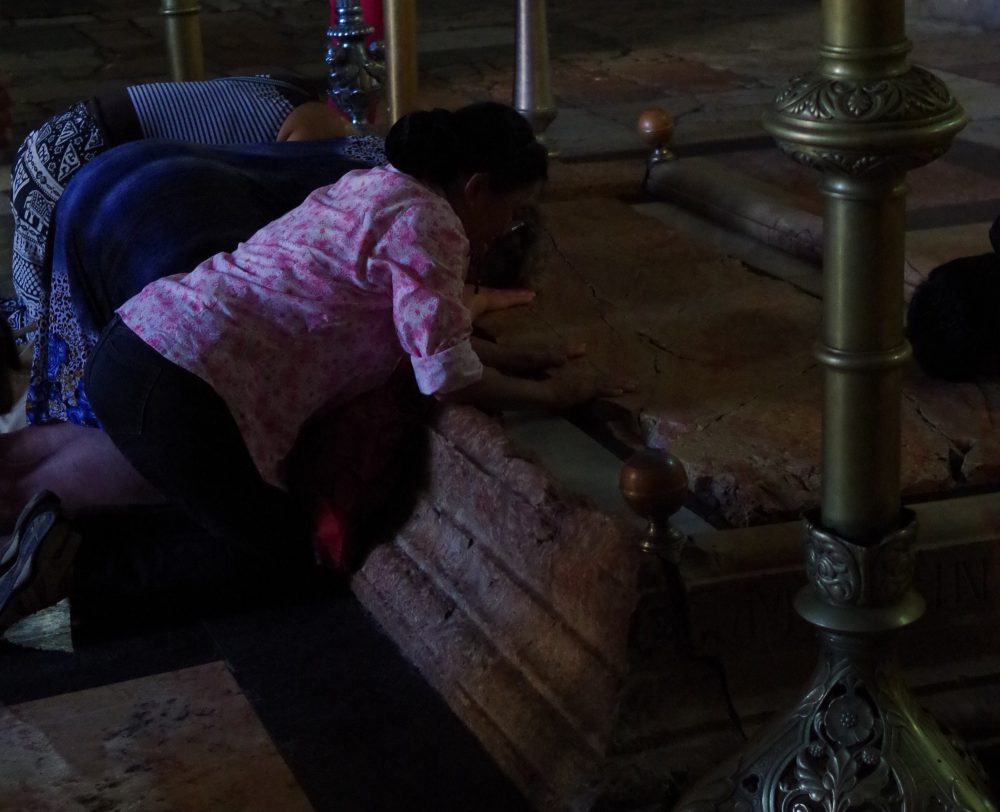
Just inside the entrance to the church is the slab on which Jesus is said to have been washed before burial. Visitors kneel with their hands on the rock, and sometimes kiss it. The same happens in each of the chapels; for example, in the Greek Orthodox chapel it is possible to crawl under the altar and kiss the stone where the crucifixion is believed to have taken place. If you are dressed modestly, you can enter the Holy Sepulchre itself, a slow process since only about three can enter at a time and many stay a few minutes to pray. To enter it requires bending down to enter the very low doorway.
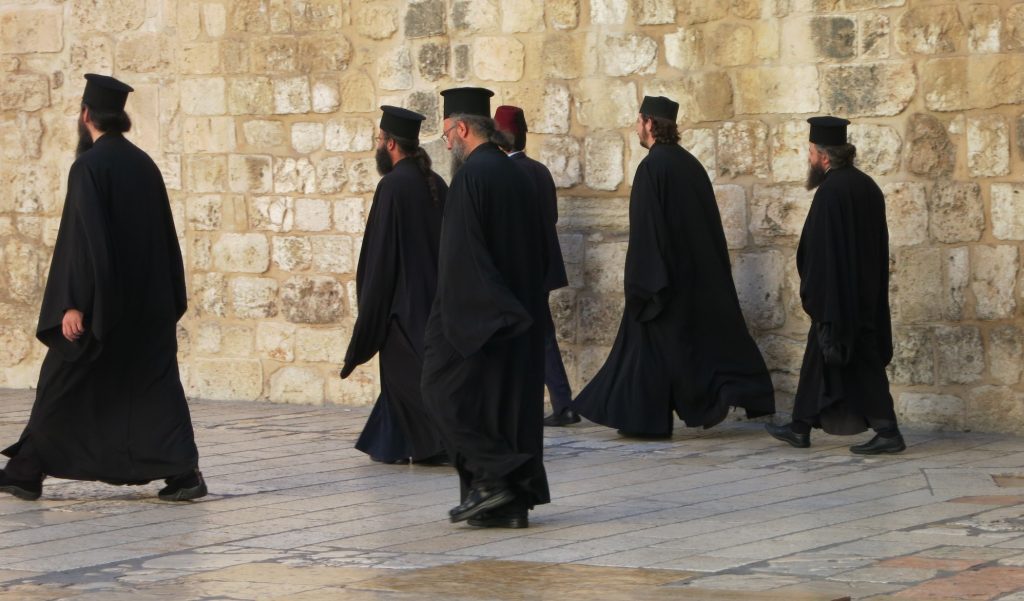
Don’t rush a visit to the Holy Sepulchre, even if you’re not a believer. Spend time inside listening to the singing and chanting. Sit outside on the plaza in front of the entrance and watch the variety of the faithful come and go.
“Via Dolorosa” means “Way of Sorrows.” The Gazans and the Israelis are wandering their own way of sorrows right now. I hope that someday soon that will end, and they can come and walk this ancient one instead. The Christian sects manage to share space through compromise; someday perhaps the Palestinians and Israelis can do the same.
If you want to read my earlier posts about this trip to Israel, here they are: Why I’m in Israel and The Mundane in Jerusalem.



A great example of how Israel welcomes so many communities and religions.
I will confess, this post and the subject matter is chalk to my cheese on where I sit in regards to views on the Israel-Palestinian conflict, and the state of Israel.
Glad to see you are safe however, and take care if the situation escalates further.
I have seen reports of Israeli troops refusing to fight.
Are you able to confirm if this is true, as hopefully this could be a step in a peaceful direction 🙂
Indeed. If only that were more generally applied…
Thanks for commenting!
Oops! That response was meant for Brad’s comment! Chris, I have no idea if there have been soldiers who refuse. I don’t know Hebrew, so I can’t follow the local coverage, but I’ll ask my cousins when I see them tonight. There is a peace movement that has protested (Google “Peace Now”) but I have the sense that Israelis are pretty united this time. They’ve reached some sort of emotional limit and want to completely stop the rocket launches into Israel, which have been going on far longer than this current crisis. Whenever I bring up the idea of simply not retaliating, so that international pressure would be on Hamas rather than Israel, they dismiss it. They simply don’t think it would work, and they don’t want to sit passively and be shot at with rockets.
What is very clear since I got here is that the media coverage is grossly oversimplified; there are far more sides to this situation than just one united Israel and one united Hamas.
Thanks for commenting!
Fascinating post, Rachel. Here’s hoping that peace finds its way to this part of the world soon.
Amen to that!
I hope you’re staying out of harm’s way, while you’re there. I am not religious either, but the history and even the controversy I’m sure makes for such a fascinating visit.
Yes, I’m keeping out of harm’s way so far (knock on wood). Experienced my first siren today, which I’ll probably blog about tomorrow! Thanks for commenting!
Dear Rachel,
With your kind permission, I would like to rock the boat. The Old City did not exist in the time of Jesus. It was built about AD130 by the Romans as a political gesture and named Aelia Capitolina. I doubt, therefore, that the Via Dolorosa is anything but a sasquatch story.
The platform known as the Temple Mount did not exist either, until it was laid out by Constantine in the 300s. His mission was to establish the cave, the Well of Souls, now enclosed beneath the Dome of the Rock, as the tomb of Christ. I think he got it right.
The true Old City, with its citadel and royal residence, I place a mile north atop Mt Scopus, principally because of military advantage. The Temple stood west of Scopus, at Ammunition Hill.
The only difference between me and an atheist is that I am not an atheist.
Hi James, thanks for your comments. I’m no expert in this, and I realize that the Via Dolorosa is only what Christians believe to be the route. Nevertheless it’s fascinating to walk the route to see the strength of that belief in action. My understanding is that the Temple Mount did exist at the time of Jesus and already had a plaza built on top of it. There are archeological remains going back several thousand years just south of the old city in what is now called the City of David. Of course, that doesn’t mean that there wasn’t also a settlement north of the city on Mt. Scopus. As I said, I’m no expert. Thanks for commenting!
Dear Rachel,
The whole thing is like the blind leading the blind. The Gospel of Luke (the Christmas story) says that the City of David is Bethlehem, a good four miles south of the Haram. Anyone who suggests that the City of David lies only a few hundred feet below the Haram is out to lunch. I perceive that you are a seeker. As such, you will be lied to, but never by me.
James
I have no idea which is correct. What I do know is that what is now called the City of David is a national park near Jerusalem where some people believe the biblical King David built his capital. You don’t have to believe that, but there is definitely a large archeological site there that dates to that period. That’s enough for me to find it interesting. I enjoy going to places like this because they hold meaning for the people who treasure them. I don’t believe in Jesus, yet I enjoyed walking the Via Dolorosa and seeing how people venerate the place. The fact that it is considered so holy is what makes it more than just another picturesque old city. I’m not going to go tap pilgrims on the shoulder and say “You know, this isn’t where Jesus walked,” partly because I don’t know for sure, and partly because it would be disrespectful and, frankly, pointless to argue with what people believe.